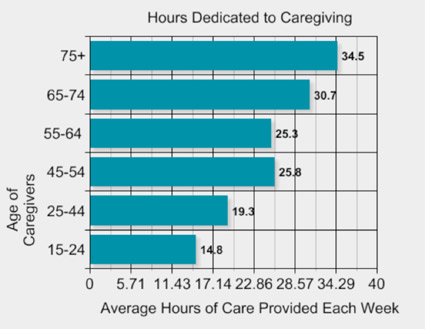Caregiving? Yeah, now there's an app for that

This chart provides a striking picture of the amount of time caregiving takes
By Gary M. Kaye
Editor, In the Boombox (
www.intheboombox.tv)
At the recently concluded 10th annual "What's Next Boomer Business Summit" the number one topic, at least based on the preponderance of attendees and presenters, was caregiving. Tens of millions of boomers are responsible for the care of aging parents and other loved ones. Sometimes their parents have been able to "age in place." In other instances they are in retirement communities, assisted living facilities, or nursing homes. But regardless of location, they all need some level of care and monitoring. We haven't found any solid statistics on the number of boomers who are caregivers, but we've found enough to paint a broad picture. Here are some statistics:
• Caregiver services were valued at $450 billion per year in 2009 – up from $375 billion in year 2007.
[Valuing the Invaluable: 2011 Update, The Economic Value of Family Caregiving. AARP Public Policy Institute.] - Updated: November 2012
• Of those caring for someone age 50-plus; the average age of caregivers is between 50-64.
[The National Alliance for Caregiving and AARP (2009), Caregiving in the U.S: National Alliance for Caregiving. Washington Updated: November 2012
Caregiving goes high tech
It's no surprise that caregiving is a major concern for boomers. And, no surprise that there are a host of efforts to bring technology to bear to help the caregiving process. Five of these technologies competed in a Mobile Apps Showcase at the Boomer Business Summit. The winner of the competition was an app from Caremerge (www.caremerge.com), which describes itself as, "…the world's first complete set of mobile and web-based apps that connects senior living community residents, staff, outside providers (hospitals, physicians, etc.) and families with real time information for timely care decisions." While this app is designed for institutional caregivers, it can result in more complete and timely information provided to family members as well.
Number two in the competition was an app called Emergency Link (
www.emergencylink.com ). This is a free service that has an available app to store your emergency information. In the event of an accident or hospitalization, first responders can have access to your medical records, your emergency contacts, your healthcare providers, even a copy of your living will or other directives. We at In The Boombox found the service quick and easy to set up on an iPhone. To protect your data, the first responder would need to use an ID code from a card or tag you would carry with you to unlock the Emergency Link app.
Perhaps the most innovative among the apps is GeriJoy (
www.gerijoy.com ). This is a tablet app intended to help patients with Alzheimer's or other dementia. It requires both an Apple or Android tablet and an Internet connection. The software creates a virtual talking dog with which the patient can converse. On the other end of the Internet connection there's a 24/7 live helper who can respond in a matter of seconds. If the patient wakes up in the middle of the night, disoriented or confused, a touch to the dog can give the time of day and a friendly voice. The live helper can alert family members or other caregivers if the need arises.
I suggest taking a look at the illustrative video (
www.gerijoy.com/video.html). The monthly cost for the service ranges between $99 and $129 and there are various hardware and connectivity options as well.
Two of the other apps entered in the competition were both journal style applications.
E-care diary (
www.ecarediary.com) offers caregivers an easy way to keep track of schedules, medications, health care contacts, and important documents all in one location.
About One (
www.aboutone.com) offers an app that is useful for the entire family, not just caregivers. It provides a central location to store documents, photos, calendars, contacts, and more.
But – do we want it?
While we can expect to see more caregiver apps coming to the market, it's not at all clear that boomers are embracing the technology. According to Julie Northcutt, who runs Chicago-based Caregiver List, there's little evidence that boomer caregivers are using these apps. Perhaps its because even taking that first step is time consuming, perhaps they are reluctant to aggregate the necessary information on a smartphone, or perhaps they just don't think it will be a value add.
But if the technology proves itself to save time and effort in the long run, there's a good chance that boomers will be on board.
Gary Kaye is the creator of In The Boombox (www.intheboombox.tv), the first website to cover technology from the Baby Boomer perspective. Kaye has been covering high tech for more than 30 years with outlets including NBC, ABC, CNN and Fox Business. He is a regular contributor to AARP and other websites on issues regarding the nexus of technology, seniors and baby boomers.

